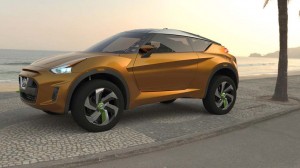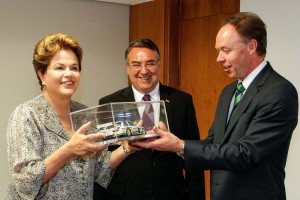
The more striking designs appearing at the 2012 Sao Paulo Motor Show - Nissan's Extrem concept shown here - reveal the intensifying competition in Brazil.
While the plan still needs final government approval, BMW is set to become the latest maker to open an automotive assembly plant in Brazil. The new factory is expected to produce about 30,000 vehicles a year once it opens in 2014 in the southern state of Santa Catarina.
Brazil is a relative latecomer to booming Brazil which, depending on how you measure it, has become the world’s third or fourth-largest national automotive market. But it’s by no means the only global automaker eyeing additional opportunities. An even bigger Nissan factory, located near Rio, is also set to open in 2014.
The pace of competition is readily apparent at this week’s Sao Paulo Auto Show in the Portugese-speaking nation’s biggest – and most traffic clogged city. Virtually every major automaker, including the “usual suspects” from Europe, the U.S., Japan and South Korea, as well as an assortment of Chinese brands, are competing for the eye of Brazil’s rapidly expanding middle-class.

Ian Robertson, BMW's global sales chief (right), presents a BMW Art Car model to the Brazilian President Dilma Rousseff (left).
“Brazil is a market with tremendous potential for the future,” said Ian Robertson, the BMW AG board member overseeing global sales and marketing, noting that his company reported a significant 54% increase in Brazilian sales last year.
The market is, in some ways, a peculiar one. Through the early-1990s, large and luxury cars dominated demand – reflecting an economy with deep poverty and a well-entrenched elite. The government kicked off demand by creating the so-called Popular Car segment which targeted entry-level buyers with stripped down models like – at the time – the original Volkswagen Beetle. Within a few years, such small and basic products overwhelmingly dominated the sales charts.
Meanwhile, recent years have seen a surge in the size of the Brazilian middle-class which is growing at a pace rivaling China’s. That has further spurred demand to the point that already traffic-clogged cities like Sao Paulo can approach regional gridlock at times.
In decades past, economic ups-and-downs often led the auto industry on a roller-coaster ride, as happened in the late 1990s after makers tentatively committed to nearly $20 billion in plant investments. But the past decade has seen an unusual level of economic prosperity and consistency – even as much of the rest of the world was melting down – further encouraging investment. BMW and Volkswagen, for example, are hoping that Brazil will help offset lagging sales in their home European market.
“Brazil is very much a cornerstone” of VW’s strategy to become the world’s largest automaker by 2018, declared VWAG CEO Martin Winterkorn, during an appearance at the Sao Paulo Motor Show.
The maker notably waited until the event – rather than last month’s Paris Motor Show – to unveil its VW Taigun Concept – a prototype crossover-utility vehicle officials say will almost certainly go into production if it receives a good reception during the show’s public days.
(For more on the VW Taigun, Click Here.)
Other key products on display at the show include the Nissan Extrem, an even more radical crossover that, while not scheduled for production, is expected to strongly influence products that will come out of the new Nissan plant.
“We made a late start here, but we want to show we are serious,” explained the Japanese maker’s global styling chief Shiro Nakamura. “Success in Brazil,” he emphasized, is vital to our plans for global growth.”
Other significant introductions in Sao Paulo include the Hyunai HB20x and the Toyota Etios, a version of the Japanese maker’s Yaris subcompact. Toyota also launches the Prius “family” for the first time in a market that is extremely sensitive to fuel costs and the geo-political problems of importing oil.
In fact, almost all the vehicles on display in Sao Paulo are available with bi-fuel technology permitting them to run on ethanol derived from the country’s abundant sugar cane crop. Unlike the U.S., demand for the renewable fuel has traditionally been quite strong in Brazil.
Market leader Fiat pulled the covers off the Bravo xtreme, a more sporty version of the current Fiat Bravo – a move that seems to suggest manufacturers are moving away from their traditionally staid and stolid approach to styling for the market and hoping to differentiate themselves with more distinctive designs.
That also reflects the challenge that mainstream manufacturers are facing as Brazil becomes a dumping ground for low-cost Chinese products that have suddenly become a major factor in this traditionally price-sensitive market,
That threatens to hurt leaders like VW, Fiat and General Motors, the latter hoping to build up its presence in emerging markets to help offset a 14-year flood of red ink from Europe. GM, in particular, was “underinvested” in the market, according to CEO Dan Akerson, who said he has corrected that.
One sign of the new approach is the launch of the all-new Opel Onix at the Sao Paulo show.
“This show is a landmark occasion for GM and Chevrolet,” said Grace Lieblien, president of GM Brazil. “Half of global GDP is coming from emerging markets. We expect Brazil, GM’s third largest global market, to top four million units by 2015 or sooner.”
Not everyone is quite so confident, at least not in the near-term. The Brazilian government has used incentives to help boost automotive demand but those subsidies may soon be ended and analysts warn that could result in a sharp fall-off in sales – though few expect that would lead to the sort of market collapse Brazil used to experience on a regular basis in decades past.
It was long a bittersweet joke among Brazilians that “Brazil was the economy of the future and always will be,” a reminder that past booms were inevitably followed by deep busts. These days, however, Brazil is very much a modern economy and one that the auto industry is desperate to capitalize on.
